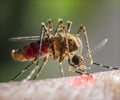Scientists believe they have found an explanation for a puzzling and serious complication of West Nile virus infection.
Scientists believe they have found an explanation for a puzzling and serious complication of West Nile virus infection.
Researchers at Washington University School of Medicine in St. Louis and Utah State University showed that West Nile virus can enter a nerve cell, replicate and move on to infect other nearby nerve cells. Viruses traveling this infectious pathway can break into the central nervous system, triggering a condition known as acute flaccid paralysis that leaves one or more limbs limp and unresponsive. No treatment is currently available for this complication. Patients must undergo rehabilitation to relearn to use the affected limb.Injection of a West Nile virus antibody, created by Washington University and a private biotechnology firm, blocked the complication in laboratory animals. The results appear online in the Proceedings of the National Academy of Sciences.
Preliminary data suggests there will be approximately 4,000 to 5,000 severe West Nile virus infections in the United States in 2007. First isolated in Africa in 1937, West Nile spread to the Middle East, Europe, and Asia before arriving in the United States in 1999. Most infections with the virus are mild or symptom-free, but infections in people with weakened immune systems and those over 50 sometimes lead to serious complications or death.
Senior author Michael Diamond, M.D., Ph.D., associate professor of molecular microbiology, of pathology and immunology and of medicine, began the new study because of a puzzling contrast in the ways West Nile virus infection affects the central nervous system.
One form of infection, encephalitis, causes inflammation of the brain and leads to fever, headaches, weakness and seizures. It is much more likely to occur in patients who are elderly or have weakened or suppressed immune systems. The other form of infection, acute flaccid paralysis, strikes patients with weakened immune systems but also affects a significant number of patients with healthy immune systems.
"Based on our mouse model of West Nile virus infection, we already knew that the most likely cause of encephalitis was virus in the blood breaking through the blood-brain barrier to infect the brain," says Diamond. "But the epidemiological contrast suggested to us that there might be a fundamentally different infectious mechanism behind paralysis."
To test their results in an animal model, scientists used a suture to close off the sciatic nerve in hamsters. Then they injected West Nile virus directly into the nerve, either above the suture (i.e., closer to the spine) or below it. Animals who received an injection below the suture came down with encephalitis. But those whose injections were above the suture developed both encephalitis and paralysis because the virus was able to follow the sciatic nerve back to the central nervous system.
"Paralysis might not require such high levels of infection," he theorizes. "What may happen instead is if a mosquito bites you and the virus is able to replicate in the vicinity of a nerve, by the time the immune system has cleared the infection in the skin, a small amount of virus may already be following the nerve back to the spinal cord. Unless you have a robust antibody response, you're probably not going to clear that fast enough, and you might get paralysis."
When scientists injected a therapeutic antibody the day after the viral injection, it blocked both encephalitis and paralysis. The antibody, developed by Washington University and Macrogenics Inc., has been licensed to Macrogenics for commercial development and is in early clinical trials in humans.
"We already knew the antibody could block encephalitis," notes Diamond, in whose laboratory the antibody was originally developed. "The levels of antibody in the central nervous system are relatively low compared to the rest of the body, but they're still high enough to block paralysis."
Diamond plans follow-up studies to see how long after infection the antibodies can be injected and still retain their protective effect against paralysis. He also plans to test whether the virus is sitting back and passively letting the nerve cell move it along or actively pushing itself forward by manipulating nerve cell physiology.
Diamond and co-author John D. Morrey have a financial interest in the antibody that is regulated in accordance with Washington University's conflict-of-interest policies.
Source-Eurekalert
VEN /J
 MEDINDIA
MEDINDIA
 Email
Email








